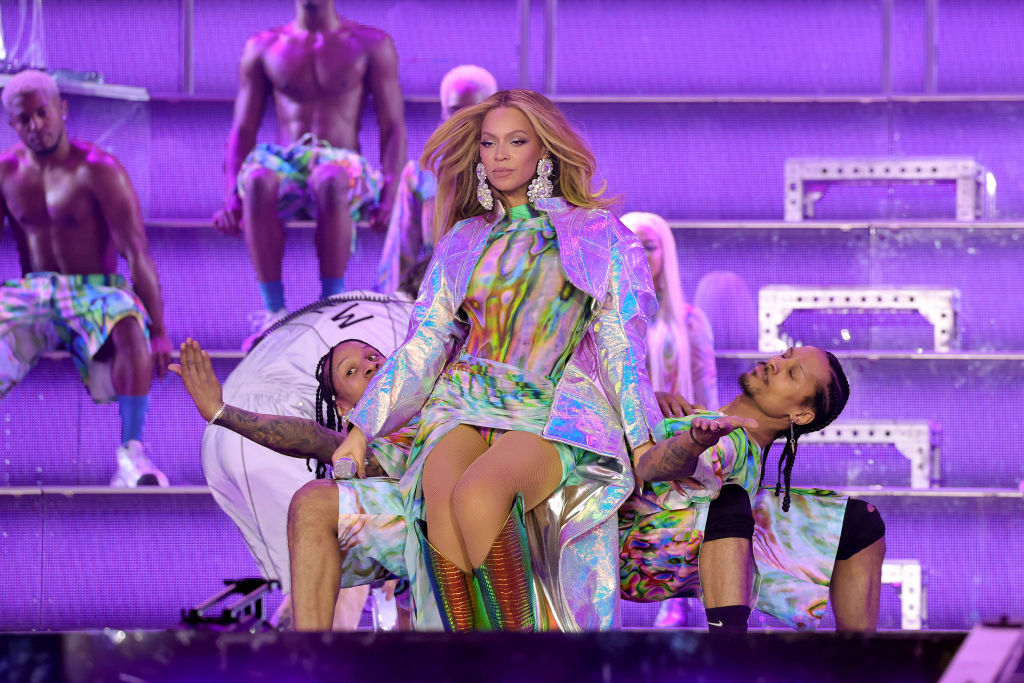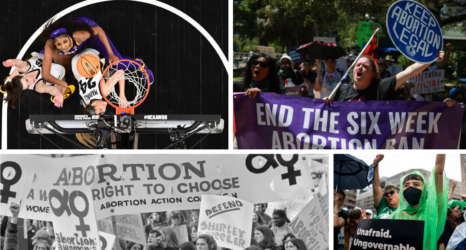If the future is anything like the atmosphere Beyoncé is creating on her world tour stage, I want to be there.

Beyoncé’s Renaissance World Tour has been making waves across Europe for the last month. I wouldn’t describe myself as a card-carrying member of the Beyhive, but I am a fan, and when someone offered me a reasonably priced ticket to the sold-out opening night in Stockholm on May 10, I bought it.
Her first World Tour since 2016, fans and cultural critics came from around the globe to see what Queen Bey would bring to the stage. Many of us were unprepared for the power she would unleash. We had to be in our seats an hour before the show began, and the venue was buzzing in anticipation. When she finally appeared, in a metallic body suit with winged shoulder pads, it quickly became apparent that the vibe of the show was Afrofuturism. Her 2020 visual album Black Is King has already been analyzed through the lens of this cultural movement, and it seems Beyoncé is continuing these futuristic visuals on her world tour.
Afrofuturism is a trending movement in literature, music and the visual arts, seen as a way of understanding the African diaspora, not by looking back, but by looking forward. This gaze towards the future is a hopeful gesture that moves beyond the traumas of the past (and present).
Characterized by elements of science-fiction, technology, cosmic exploration and alternate realities, it has been exploding in popular culture.
The 2018 and 2022 Black Panther movies are the most mainstream examples, but the themes have been evident in Black culture, especially literature, since the 1960s (the Marvel comic character Black Panther first appeared in 1966). Octavia Butler’s Kindred (1979) is often referenced as an example of an early Afrofuturistic novel, but some have read Ralph Ellison’s Invisible Man (1952) as Afrofuturistic. Contemporary literary examples include Marlon James’s Dark Star Trilogy, Rivers Solomon’s The Deep (2019) and Ta-Nehisi Paul Coates’s Water Dancer (2019). In music, Sun Ra is often noted as one of the early trailblazers with his Afrofuturistic jazz, but female artists have contributed greatly to this genre, including the group Labelle, Nona Hendryx, Grace Jones (who features on Beyoncé’s new albumin the song “Move”), Erykah Badu, and more recently Janelle Monáe.
With the title of her latest album, Beyoncé may be suggesting a renaissance of Afrofuturism.
But how is Beyoncé using this speculative aesthetic? And what does an Afrofuturistic world tour say about the world today? After opening with a ballad rendition of “Dangerously in Love,” showcasing part of the artist we seem to have forgotten in all the spectacle around her—she can really sing—the massive backdrop of a cloudy blue sky lifted, revealing a stage set and video imagery more in line with the Renaissance album cover—which features Beyoncé looking like a Black Lady Godiva atop a holographic horse set against a black background. The color scheme for the stage set was black and metallic.
At one point, Beyoncé appeared as a robot, at another, when she sang “Church Girl,” she wore a metallic circular flat hat (reminiscent of this one from Balmain she wore on the April cover of French Vogue). While singing, “I’m That Girl,” she wore a silver leotard with one black glove, which she raised in a Black Power salute with her dancers—an action incorporated into her shows since the 2016 Super Bowl.
And while the metallic colors alone suggest an idea of the future as “shiny” and “high-tech,” the most dazzling moment was the intro to “Church Girl,” where she appeared in a white gown that was lit up like a stained-glass church window through the use of a UV light, which shimmered down her gown. The costuming forces us to imagine a future beyond what we currently see as possible.
In the New York Times review of Black Is King, fashion critic Vanessa Friedman wrote that Beyoncé’s high couture costumes, made primarily by white designers, did not fit within the film’s overall message of Black pride as they did not reimagine a narrative of fashion as written by Black designers. This is true too of the Renaissance World Tour, where according to Harper’s Bazaar, the major costumes are designed by Alexander McQueen, Loew and David Koma. And while we would all like to see a rewrite of the white fashion industry, if we analyze the clothes in the show not for who designed them, but for how they look on stage, on Beyoncé, in the context of the show’s visuals and musical tributes, we see a clear synthesis of Afrofuturistic aesthetics and Black female empowerment.
The video imagery projected behind Beyoncé throughout the show included stars and galaxies (similar to what we saw in Black Is King), but also robots, holographs and scientifically altered humans, including Beyoncé’s own body augmented in various ways. This unearthly, futuristic imagery is embodied in “Alien Superstar,” with lyrics such as, “I’m too classy for this world.”
But far from being alien from her fans, the best part of the show was seeing how human this megastar is. She laughed with the audience, blew kisses, whispered back “I love you.” At one moment she said, “I see you. I see you in your silver and your cowboy hats, thank you.” The woman next to me was wearing a silver sequined cowboy hat, which has been called the “must-have accessory” of the tour, a nod to Beyoncé’s home state of Texas, the signature color of the Renaissance album, as well as the history of queer disco culture behind many of the tracks.
At another moment between songs, Beyoncé looked at the audience and said, “Y’all make me so happy.” Her face was glowing. To be in that audience, dancing and singing with the fans, feeling that kind of joy, was an out-of-this-world experience.
Afrofuturism has historically been a male-dominated cultural movement, according to writer Jonita Davis. There is more at stake for Black women participating in this genre. For Black women, it is not about inserting themselves into a sci-fi aesthetic, but rather an attempt to envision a future that accommodates the Black female experience.
In her review of Renaissance, Ms. contributor Janell Hobson calls the album a futurist fantasy of Black joy, that “effortlessly interweaves sound technologies across space and time in the most Afrofuturistic sense to connect Black communal sites of pleasure: from the ballroom to the dance club to the house party.” What Beyoncé is doing on this album, and on stage, is celebrating these histories of Black joy and demonstrating self-love as a powerful tool for Black worldmaking.
Perhaps the most futuristic moment of the tour to date was when she brought her 11-year-old daughter, Blue Ivy, on stage in Paris—as if to say, ‘It is not for me we are doing this, but for our daughters.’
And the truth is, there is still something futuristic about a Black woman in a position of power, and anyone in a position of power using it to create collective joy and love. If the future is anything like the atmosphere Beyoncé is creating on her world tour stage, I want to be there.
Beyoncé’s Renaissance World Tour ends September 27 in New Orleans.
I am grateful to Helen Gibson, Hilary Anderson, and Michaela Vance for providing feedback and inspiration for this article.
Up next:
U.S. democracy is at a dangerous inflection point—from the demise of abortion rights, to a lack of pay equity and parental leave, to skyrocketing maternal mortality, and attacks on trans health. Left unchecked, these crises will lead to wider gaps in political participation and representation. For 50 years, Ms. has been forging feminist journalism—reporting, rebelling and truth-telling from the front-lines, championing the Equal Rights Amendment, and centering the stories of those most impacted. With all that’s at stake for equality, we are redoubling our commitment for the next 50 years. In turn, we need your help, Support Ms. today with a donation—any amount that is meaningful to you. For as little as $5 each month, you’ll receive the print magazine along with our e-newsletters, action alerts, and invitations to Ms. Studios events and podcasts. We are grateful for your loyalty and ferocity.





